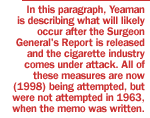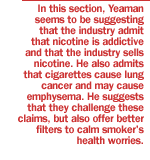
 |
 |
 |
 |

 |  |

|

..............Whatever qualifications we may assert to minimize the impact of
the Report, we must face the fact that a responsible and qualified group of
previously non-committed scientists and medical authorities have spoken. One
would suppose we would not repeat Dr. Little's oft reiterated "not proven".
One would hope the industry would act affirmatively and not merely react
defensively. We must, I think recognize
that in defense of the industry and in preservation of its present earnings
position, we must either a) disprove the theory of causal relationship or b)
discover the carcinogen or carcinogens, co-carcinogens, or whatever, and
demonstrate our ability to remove or neutralize them. This means that we must
embark--in whatever form of organization--on massive and impressively financed
research into the etiology of cancer of the lung. Certainly one would hope to
prove there is no etiology of cancer as it relates to the use of tobacco; what
constituents or combination of constituents in cigarette smoke cause or are
conducive to cancer of the lung. Certainly one would hope to prove there is no
etiological factor in smoke but the odds are greatly against success in that
effort. At the best, the probabilities are that some combination of
constituents of smoke will be found conducive to the onset of cancer or to
create an environment in which cancer is more likely to occur.
 |  |

|

......Thus to accept its responsibility would, I suggest, free the industry to
take a much more aggressive posture to meet attack. It would in particular
free the industry to attack the Surgeon General's Report itself by pointing out
its gaps and omissions, its reliance on statistics, its lack of clinical
evidence, etc., etc. True we might worsen our situation in litigation, but
that I would risk in contemplation of the greater benefits to be derived from
going on the offensive. My record of advice in this area may well justify the
charge of inconsistency, but let me say that so long as the industry does not
assume its research responsibility my long-held position would remain unchanged
and I would oppose either outright attacks on the Surgeon General's Report or
the giving of assurance to the smoking public not supported by research
evidence.
There is however the problem of what to do until the doctor comes and this
leads me to the second of the two measures I would urge the industry to
take:
2. The Surgeon General's Report will, of course set off attacks all along the
line. Our harsher critics--Senators Moss and Neuberger, the American Cancer
Society, et al. will immediately press for all sorts of restrictive and
repressive programs:
a) Public education directed particularly at the young.
b) Much harsher FTC rules in respect of cigarette advertising, with
restriction of the scope and control of content thereof. One might anticipate
rules seeking to prevent the use of "glamour situations", endorsements
including those of athletes, prominent entertainment figures, etc., and quite
likely an effort to bar tobacco advertising from television and radio.
c) "Content" labeling or cautionary legends.
d) FTC to be given power of preliminary injunction in respect of cigarette
advertising.
e) Repressive taxation.
 |  |

|

..............To accomplish anything effective, the Institute needs the
leadership of a strong tobacco figure, e.g., Albert Clay, Paul Hahn,
etc., a highly expert trade association staff including experienced and
respected lobbyists and, lastly, such adornments of public figures an
appearance and occasion warrant.
The question immediately arise: how would such aggressive posture affect
litigation? With one exception (Green v. American Tobacco Co,), those actions
which have gone to judgment were won by the defendants on the defense of
assumption of risk. The issuance of the Surgeon General's Report will, in my
opinion, insure the success of that defense as to causes of action arising in
the future if the industry can steel itself to issuing a warning. I
have no wish to be tarred and feathered, but I would suggest the industry might
serve itself on several fronts if it voluntarily adopted a package legend such
as "excessive use of this products may be injurious to health of susceptible
persons: and would embody such a legend in pica in its shocking--that I would
rather not try to anticipate the arguments against it in this note but reserve
my defense.
It is difficult to assess the effect of the Report on causes of action arising
prior to its issuance. Logically, it would be argued, the Report does no more
than to collate pre-existing knowledge, knowledge as available to the buyer as
the seller. But logic might--in the minds of a jury--yield to the emotional
reaction that if this knowledge was available to the seller it was up to him,
having the means to do so, to make the product safe. A jury might,
whether instructed or not, operate on the theory of comparative negligence:
"True the buyer was negligent in smoking a product he knew was dangerous, but
he was lulled by the seller and the seller's negligence was the greater in
failing to make his product safe.
 |  |

|

............................."Our investigation definitely shows that both
kinds of drugs (Rauwolfin alkaloids and nicotine) act quite differently, and
that nicotine may be considered (its cardiovascular effects not being
contemplated here) as more 'beneficial'--or less noxious--than the new
tranquilizers, from some very important points of view.
"The so-called 'beneficial' effects of nicotine are of two kinds:"
"1. Enhancing effect on the pituitary-adrenal response to stress;"
"2. Regulation of body weight."
"These effects do not seem to be shared by reserpine, which on the contrary
shows undesirable side-actions that are not given by nicotine, i.e. a nearly
complete blockade of gonadic and thyroid activities, reflecting most probably
a general blockade of the hypothalamo-pituitary system, which normally controls
all the endocrine activities."
Moreover, nicotine is addictive.
We are, then, in the business of selling nicotine, an addictive, drug effective
in the release of stress mechanisms. But cigarettes--we will assume the
Surgeon General's committee to say--despite the beneficent effect of nicotine,
have certain unattractive side effects:
1) They cause, or predispose to, lung cancer.
2) They contribute to certain cardiovascular disorders.
3) They may well be truly causative in emphysema, etc. etc.
We challenge those charges and we may have assumed our obligation to determine
their truth or falsity by creating the new Tobacco Research Foundation. In the
meantime (we say) here is our triple, or quadruple or quintuple filter, capable
of removing whatever constituent of smoke is currently suspect while delivering
full flavor--and incidentally--a nice jolt of nicotine. And if we are the
first to be able to make and sustain that claim, what price Kent?
Dare we as a matter of policy make such claims? If they are true and if we
make no claim of freedom from danger--indeed, if we cry caution--why should we
not ? I would submit that the FTC in the face of 1) the industry's research
effort, 2) the truth of our claims, and 3) the "public interest" in our filter,
cannot successfully deny us the right to inform the public.
As for litigation, it would be my opinion that we would not put ourselves in
substantially worsened position and in any event a successful Avalon could be
expected to satisfy a number of judgments for damages.
Have we an obligation to make our knowledge available to our competitors? If
the Griffith claims stand up and when we have perfected the Griffith filter and
stocked, the necessary machinery, etc., then I suggest there is strong moral
obligation on us to make our knowledge public and free. And think of the
kudos. I will be vastly surprised if such disclosure markedly adds to our
competitors' knowledge but that is beside the point.
The point is: On this new terrain, permitting strong offensive action, we
get there fastest with the mostest.

home .
discussion .
quiz .
the criminal probe .
will there be a deal? .
a look at the depositions .
big tobacco - what's at stake .
interviews
timelines .
faqs .
links & readings .
synopsis .
tapes & transcripts .
press reaction
frontline online .
wgbh .
pbs online
web site copyright WGBH educational foundation
|  |
|